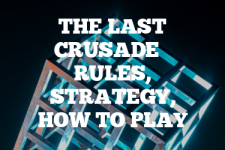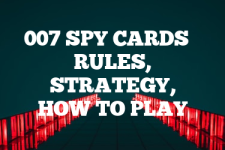The Lord of the Rings Trading Card Game: A Guide to Strategy and Gameplay
Introduction
The Lord of the Rings Trading Card Game is a really cool collectible card game that transports players into the heart of J.R.R. Tolkien’s Middle-earth. This game was first released in 2001, coinciding with the launch of the blockbuster films, and quickly gained a dedicated following in playing circles I’m a part of, at least. Players build decks featuring characters, artifacts, and events from the Lord of the Rings universe, and they battle it out to complete quests and overcome their opponents.

As a seasoned player, I’ve spent countless hours enjoying the strategic depth and rich thematic elements of The Lord of the Rings Trading Card Game. Although the game is no longer in print, the community remains active, and cards are still traded among enthusiasts. Whether you’re a fan of the books, movies, or just love a good card game, this guide will help you understand the basics and get you started on your journey to becoming a master of the game.
Quick Tip for The Lord of the Rings Trading Card Game
Always balance your deck with a mix of character, event, and equipment cards to handle any situation that comes your way.
Rules for playing The Lord of the Rings TCG
Understanding the rules is crucial for any player looking to dive into The Lord of the Rings Trading Card Game. The game is played between two players, each with their own deck of cards representing Free Peoples and Shadow forces. The goal is to guide your Fellowship through Middle-earth, completing quests and overcoming obstacles, while your opponent tries to halt your progress with their Shadow cards.
The game is divided into turns, each consisting of several phases. Players alternate taking turns, with the Free Peoples player going first. During your turn, you’ll draw cards, play characters and attachments, and engage in skirmishes with your opponent’s forces. Managing resources, known as “twilight points,” is essential, as they are used to play cards from your hand.
Combat is a key aspect of the game, and it’s resolved through skirmishes. Characters have strength values, and the higher strength wins the skirmish. However, strategy comes into play with event cards that can turn the tide of battle. The game continues until one player’s Fellowship reaches the final site, or the Ring-bearer is corrupted and overcome by the Shadow forces.
Card Types for LoTR CCG
There are several types of cards in The Lord of the Rings Trading Card Game:
- Character Cards: These represent the heroes and villains of Middle-earth.
- Event Cards: Used to influence battles, quests, and other aspects of the game.
- Attachment Cards: Equipment and artifacts that enhance character abilities.
- Site Cards: Represent the various locations your Fellowship travels through.
Decks are typically built with a balance of these card types, and starter sets are available to help new players learn the game mechanics.
Card Sets
The Fellowship of the Ring – Launched on November 6, 2001, a month prior to the film debut of the similarly titled movie, The Fellowship of the Ring established the foundational template for subsequent sets. As the inaugural “base set,” it initiated a release pattern that would characterize the Movie block’s distribution rhythm: an initial base set to establish the core, succeeded by two expansions to enhance and complete the series. The Fellowship set primarily drew inspiration from the intense battle scenes of the initial film. Cards depicting Elves and Gondor showcased moments from the opening confrontation with Sauron, while Moria and Isengard cards centered around characters like the Cave Troll of Moria and Lurtz, Servant of Isengard. With the game being new at the time, the dominant strategies often hinged on overpowering the opponent, aligning with what newcomers to the game would anticipate. Fellowship stands out as the only set to feature “prophetic” cards, hinting at future cards yet to be introduced. The Bridge of Khazad-dum card was unique as the sole site 5 in the set, which was essential for gameplay, leading to player bewilderment when the expected Balrog was absent from the spoiler list. The first two versions of the Balrog eventually appeared in the Mines of Moria expansion, released four months later, with the site card serving as a teaser for upcoming enhancements. In a similar vein, Sam, Faithful Companion made mention of Bill the Pony, who wouldn’t be available until the release of the Realms of the Elf-lords set. As the inaugural set, Fellowship has been on the market the longest, resulting in an abundance of affordable booster packs and starter decks, making it an ideal starting point for newcomers, just as it was upon its initial release.
The Mines of Moria – the first expansion for the Lord of the Rings Trading Card Game marked a significant development, introducing new strategic elements and essential cards. Continuing from where the initial “Fellowship” series concluded, this expansion shifted the emphasis towards the Dwarves and the denizens of Moria, bringing to the game distinctive minions like The Watcher in the Water, Keeper of Westgate, and a duo of formidable Balrog iterations, as hinted at in the previous set. The expansion also debuted artifacts such as Gandalf’s Staff, Mithril-Coat, The Balrog’s Sword, and the Whip of Many Thongs. For the first time, players encountered cards explicitly designed to counter the Nazgul, with cards like Release the Angry Flood, Flaming Brand, Not Feared in Sunlight, and O Elbereth! Gilthoniel! standing out. Concurrently, a fresh Nazgul strategy was unveiled: Twilight Nazgul. The set was also notable for its powerful rare cards like Secret Sentinels, Uruk Captain, Bill Ferny, Swarthy Sneering Fellow, Tower Assassin, and A Promise. Acclaimed as an excellent starting point for newcomers, “Mines of Moria” offered starter decks that provided a comprehensive experience of the game’s phases and introduced two robust strategies. The addition of Gimli, Dwarf of the Mountain Race, and Gandalf, the Grey Pilgrim greatly enhanced Fellowship-based play styles. In subsequent formats, certain “Mines of Moria” cards were X-Listed, notably Flaming Brand and Filibert Bolger, Wily Rascal, in the Towers Standard (1-6). However, Filibert Bolger, Wily Rascal was later removed from the X-List with the release of “The Return of the King” and accompanying changes to the rules about cancelling ring-bearer skirmishes. Mines of Moria is probably the most overproduced set in Lord of the Rings TCG, which means the cards are still cheap and easy to come by.
Realms of the Elf Lords – this expansion significantly enhanced the strategic gameplay of the Lord of the Rings Trading Card Game. This addition primarily spotlighted the Elven factions from Rivendell and Lothlorien, introducing a fresh group of minions with Isengard Orcs, significantly augmenting the Sauron discard tactic, and bringing in new cards designed to maintain the Fellowship’s vitality. The expansion also debuted a fresh rendition of Aragorn, a pair of Arwen companions, and the starter deck allies, Legolas and Boromir. Furthermore, “Realms of the Elf Lords” marked the introduction of Saruman as a playable character, as well as the Elven rings of power: Narya, Nenya, and Vilya. Notable “Power” rare cards from the set included characters and items such as Elrond, Herald to Gil-Galad; Aragorn, Heir to the White City; Gondor Bowmen; Horn of Boromir; Saruman, Keeper of Isengard; and The Shire Countryside. This set also featured other sought-after cards like Frying Pan, Might of Numenor, and Bill the Pony. The starter decks in this expansion presented new versions of Legolas, Son of Thranduil and Boromir, Defender of Minas Tirith, with Legolas, Son of Thranduil also being promoted as a featured pre-release card. Despite the fact that the starter decks from “Realms of the Elf Lords” were often criticized for their suboptimal strategies, collectors and players still sought them out for the opportunity to acquire the powerful rare cards they contained. Several cards from this set, including Bill the Pony, Horn of Boromir, Aragorn, Heir to the White City, Saruman, Keeper of Isengard, and The Palantir of Orthanc, were later X-Listed in subsequent play formats due to their strength. “Realms of the Elf Lords” stands as one of the most sought-after sets, with sealed products being particularly challenging to find on the market.
How to Play The Lord of the Rings Trading Card Game and Game Mechanics
Playing The Lord of the Rings Trading Card Game involves several key mechanics:
- Setup: Each player starts with a deck and a Fellowship consisting of one Ring-bearer and possibly other companions.
- Gameplay: Players take turns playing cards, moving their Fellowship, and engaging in skirmishes.
- End of the Game: The game ends when the Fellowship reaches the final site or the Ring-bearer is corrupted.
Understanding these mechanics is essential for a successful game.
How to Win at LoTR CCG
Winning at The Lord of the Rings Trading Card Game requires a combination of strategy, deck building, and adaptability. Beginners should focus on learning the card effects and basic strategies, while intermediate players can explore more complex combos and deck archetypes. Advanced players often delve into the metagame, predicting opponents’ strategies and adjusting their decks accordingly.
Best Strategies for playing The Lord of the Rings Trading Card Game
To excel at The Lord of the Rings Trading Card Game, players should:
- Understand the strengths and weaknesses of their deck.
- Anticipate the opponent’s moves and prepare counter-strategies.
- Manage resources effectively to maintain a strong position.
- Adapt to the evolving game state and make tactical decisions.
These strategies can help players gain an edge over their opponents.
Deck Building and Best Cards in The Lord of the Rings Trading Card Game
Building a strong deck is crucial for success in The Lord of the Rings Trading Card Game. Players should consider the synergy between cards and aim for a balanced deck that can handle various situations.
Best Cards in The Lord of the Rings TCG
Some of the best cards in the game include powerful characters like Aragorn and Gandalf, as well as impactful events and attachments. These cards can significantly influence the game’s outcome.
Scenarios
Players may encounter both good and bad scenarios during the game. It’s important to remain calm and think strategically to turn any situation to your advantage. Whether you’re facing a powerful enemy force or have the opportunity to complete a quest, every scenario presents a chance to outmaneuver your opponent.
Additional Subtopics
Other relevant subtopics for The Lord of the Rings Trading Card Game include tournament play, community events, and the secondary market for cards. Engaging with the community can enhance the gaming experience and provide opportunities for competitive play.
External Links

Eve Brownlee was a gamer before gaming communities on the internet were a thing. Eve grew up playing traditional, standard deck card games like Rummy and Bezique, taking an interest in the classics Backgammon and Chess. Parlor card games like Bridge continue to keep Eve active in the community. After a long career, primarily in horticulture for USDA in Maryland, Eve now travels and writes on The Pineapple (pineapples.info) and contributes to Quora/Pinterest topics. Contact Eve via email.



